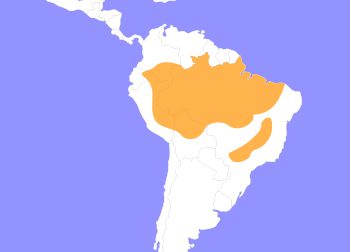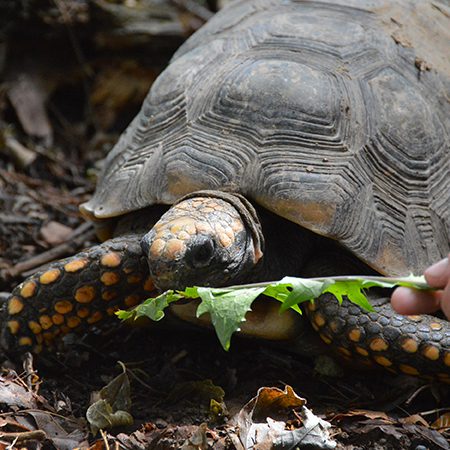Yellow Footed Tortoise
Chelonoidis denticulatus
These tortoises are also known as the yellow-legged tortoise, Brazilian giant tortoise, or South American forest tortoise. They are found in northern South America in grasslands, savannah, and sometimes rainforests. They eat a variety of foods, including plants, fruit, carrion, mushrooms, and slow-moving invertebrates. Their shell is generally a dark brown on top and yellow underneath. They have long, domed shells that are mostly smooth. The forelimbs have five pointed scales that are yellow to orange in color. They are distinguished from the red footed tortoise because the reds have red spots instead of yellow. There are also yellow spots on top of their heads.
These tortoises are the fifth largest in the world, and third largest mainland (behind the African Spurred and Leopard tortoises). They are generally 1-2 ft in length, but have been known to get larger and weigh an average of 30 lbs. Males have curved in sides, almost like they have a waste, and their plastron (lower shell) is caved inward much more than the females. This is because females need more space to develop eggs in their body. Though not aquatic and cannot swim, they do enjoy being in water.

Yellow Footed Tortoises are found in the Amazon Basin of South America.
HABITAT -They are found in the humid rainforests of South America.
DIET -Their diet includes grasses, succulents, fruit, and even carrion.
FUN FACT -They are very good at swimming short distances which helps them navigate their rainforest homes during rainy season.
SOCIAL BEHAVIOR -Outside of mating season, they are solitary.
ACTIVITY -They are diurnal, being active during the day.
PREDATORS -Beyond youth, humans are the biggest predators to these animals.
SIZE -They are 1-2 ft long and weigh around 30 lbs.
RELATIVES -Their closest relative is the red footed tortoise, which has red spots instead of yellow on their legs.
CONSERVATION -They are listed as VU (Vulnerable) according to the IUCN.
Cub Creek Animal Care Information
Housing - Our yellow footed tortiose has seasonal housing to accommodate his need for warm temperatures. In the summer, he lives in the Pentagon with our cavies and wallabies to enjoy the Missouri summer heat. He has a large area to explore, and is given a small pond to cool off in. When the temperatures start to drop, he is moved to Lemur Landing and gets to hang out with some of our lemurs, bettongs, and various birds.
Diet - All of our tortoises are fed a mixture of fruits and vegetables, along with a calcium supplement to keep their shells strong and healthy. Their diet mainly consists of apples, sweet potato, and lettuce. Occasionally they’ll get treated with various other fruits and vegetables; a favorite of theirs is eggplant!
Enrichment - Our slow-moving tortoises definitely aren’t going to play chase, so instead for enrichment we give them various places to hide or climb over. During the summer, the campers will make puzzle boxes out of cardboard or put their food in novel locations, so the tortoises have to find it.

